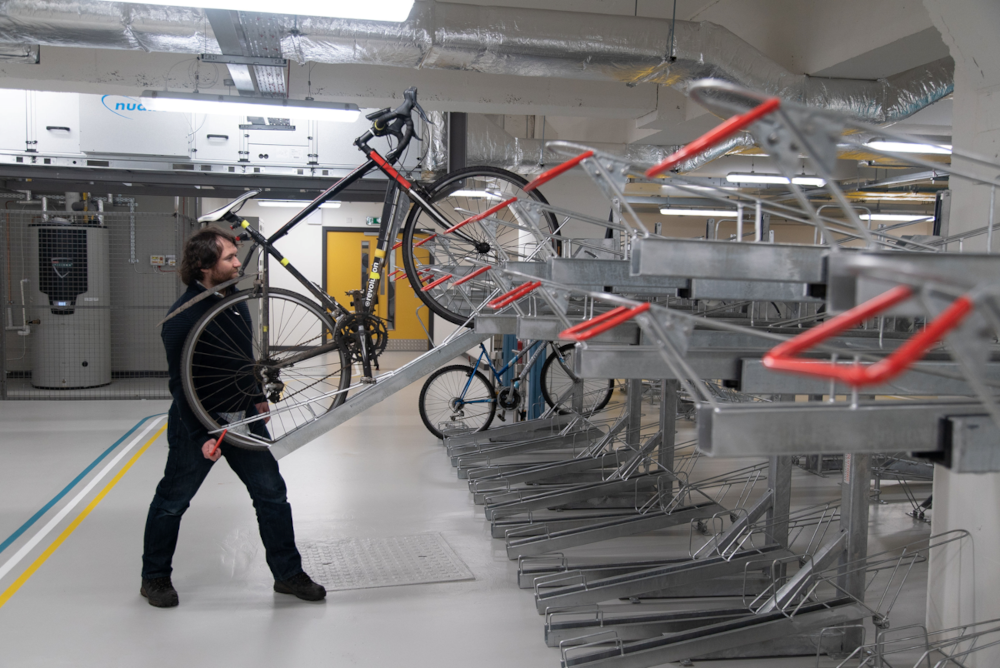Urban spaces are becoming increasingly congested, which has led to more people picking up cycling. This, in turn, has led to a growing demand for cycling infrastructure, especially in busy urban centres. The rising need, combined with the typically tight spaces and lack of large empty areas left, has created its own problem—fitting dozens of bikes in already cramped locations.
Two-tier bike racks offer a practical solution for maximising bicycle storage in limited spaces. They really are one of the coolest solutions on the market and offer two in the space of one kind of savings, which are so vital to urbanised locations. These racks offer effectiveness and user convenience, and you can’t go wrong in choosing them for most locations. Still, we’ve selected a few that would truly benefit from two-tier bike racks for maximum efficiency, space utilisation, and accessibility.
Train and Bus Stations
Public transportation hubs are prime locations for two-tier bike racks. They are typically large places, but they have anything but easy-to-find free spaces. Many stations across the UK are old, meaning they weren’t built in the last few decades when cycle parking truly became a thing. This means they don’t have any existing provisions for it, and every corner is likely already occupied by one amenity or another.
However, many commuters use bicycles as a first—or last-mile solution, and providing ample bike storage at train and bus stations encourages multimodal transportation and is vital in encouraging more active travel.
This is why two-tier racks are such a perfect fit—they help accommodate many bikes without occupying excessive space and can easily be retrofitted into existing indoor or outdoor structures.
University and College Campuses
Educational institutions have a high concentration of students and staff who rely on bicycles for commuting. Students are often cost-conscious, and many save money where they can, riding a bike being a top alternative to a pricey bus pass. They are also more likely to be of the generation that is fully embracing greener lifestyles and is committed to contributing to lowering carbon emissions.
Installing two-tier bike racks in strategic areas such as halls, lecture buildings, libraries, and sports centres can enhance campus mobility and reduce bicycle clutter. Two-tier racks are perfect because they maximise your space and allow you to fit in pretty much any model bike with minimal effort, making them accessible and easy to use.
Workplaces and Business Districts
Increasing amounts of employees prefer cycling to work as an eco-friendly and cost-effective commute option. There is a growing trend for more eco and health-conscious living and offices, and larger clusters of employers can easily make life better for their staff by implementing some much-needed bike storage. This will make current cyclists very happy and give a friendly push to some still on the fence.
Placing two-tier bike racks near office buildings, co-working spaces, and business hubs can encourage cycling while reducing the demand for car parking spaces.
Shopping Centres and Retail Areas
Shopping areas are another place that can benefit from secure and efficient bike storage to encourage more clients and employees to cycle there. Although shopping centres are typically newer, this isn’t to say that during their development stage, bike parking provisions were made. There might be a need to repurpose an existing part of the car park or an indoor storage space, and space-saving might be a top concern here, too.
So, installing two-tier bike racks is still your best bet for giving cyclists what they need without taking up too much space, which can be used for extra retail units or anything else the shopping area might need.
Residential Complexes
Apartment buildings and gated communities benefit from secure and space-saving bike storage solutions just as much as any other building. Two-tier bike racks installed in underground parking lots, courtyards, or designated cycling areas help residents store their bikes safely and efficiently. Residential developments might not be at the top of the list for places needing to save space, but it really depends on their location and size. The space-saving need is just as bad in urban residential developments as in other buildings. Besides, there is often a higher pressure to maximise the area as developers appreciate every square meter that can be used and sold as living space to make more profit. This often leads to other amenities falling by the wayside.
Public Parks and Recreational Areas
Cyclists frequently visit parks, trails, and sports complexes for leisure and exercise. Safe and secure bike parking is a must in these places, and it would be greatly appreciated if it were available.
Two-tier bike racks near park entrances, sports stadiums, and fitness centres offer cyclists a secure place to store their bikes while enjoying outdoor fun and leisure activities.
Government and Public Buildings
Public institutions, city halls, and other public buildings should encourage cycling among employees and visitors. These places often employ large numbers of staff, and installing bike racks in these locations supports government-led sustainability initiatives and lowers car dependency.
The same applies to other public buildings which can lead by example, like tourist spots, museums, historical sites and libraries. Installing two-tier bike racks in these areas can accommodate tourists while keeping pathways clear of improperly parked bikes.
Two-tier bike racks are an excellent solution for maximising bicycle storage in space-constrained urban areas and not just. Whether installed at transport hubs, educational institutions, workplaces, shopping centres, residential complexes, or public spaces, they help encourage cycling while maintaining organisation and accessibility.
By strategically placing these racks in high-demand locations, cities and businesses can promote sustainable commuting, reduce congestion, and create a more bike-friendly environment. Investing in efficient bike storage solutions is a step towards a greener, more accessible future. As cycling continues to grow in popularity, ensuring that infrastructure keeps pace with demand is crucial. Well-placed two-tier bike racks not only support current cyclists but also encourage more people to embrace biking as a viable mode of transport.

